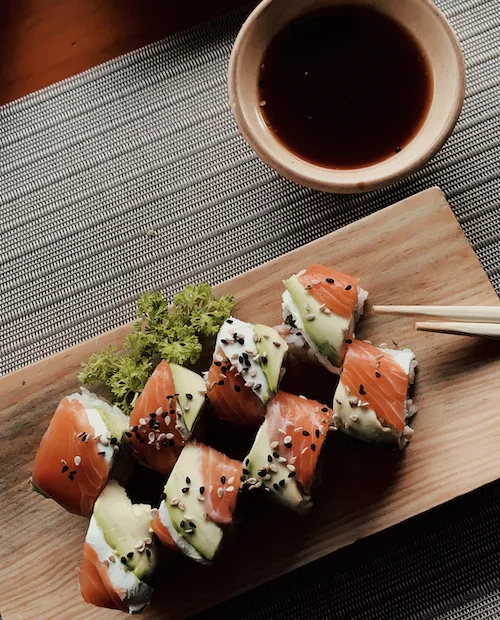Sushi is a Japanese dish that typically consists of cooked vinegared rice, known as “sushi rice,” combined with other ingredients, such as raw seafood, vegetables, and sometimes fruits. Sushi is often served with soy sauce, pickled ginger, and wasabi.
Ingredients of sushi
The ingredients of sushi can vary widely depending on the type of sushi being made. However, some common ingredients used in sushi include:
- Sushi rice
- Nori seaweed
- Soy sauce
- Wasabi
- Pickled ginger
- Fish (such as tuna, salmon, and eel)
- Vegetables (such as cucumber, avocado, and carrot)
- Fruits (such as mango and strawberry)
Is sushi vegan?
Sushi can be both vegan and non-vegan, depending on the ingredients used. Traditional sushi often includes raw fish or other seafood, which makes it non-vegan. However, sushi can also be made with entirely vegan ingredients, making it a great option for vegans.
Non-vegan sushi ingredients
Non-vegan ingredients commonly found in sushi include:
- Fish (such as tuna, salmon, and eel)
- Octopus
- Shrimp
- Crab
- Squid
- Roe (fish eggs)
Vegan sushi options
There are many vegan sushi options available, including:
- Vegetable sushi rolls
- Avocado sushi rolls
- Cucumber sushi rolls
- Sweet potato sushi rolls
- Mango sushi rolls
- Shiitake mushroom sushi rolls
- Asparagus sushi rolls
How to make vegan sushi?
Making vegan sushi is relatively simple and can be done at home. Here is a basic recipe for vegan sushi rolls:
Ingredients
- Sushi rice
- Nori seaweed sheets
- Soy sauce
- Wasabi
- Pickled ginger
- Vegetables (such as cucumber, avocado, carrot, and asparagus)
Instructions
- Cook the sushi rice according to the package instructions and let it cool.
- Lay a sheet of nori seaweed on a sushi mat.
- Wet your hands and spread a thin layer of sushi rice over the nori seaweed.
- Arrange the vegetables in a line on top of the sushi rice.
- Roll the sushi mat tightly, pressing down as you go.
- Use a sharp knife to slice the sushi roll into bite-sized pieces.
- Serve with soy sauce, wasabi, and pickled ginger.
Is sushi healthy?
Sushi can be a healthy option if you choose the right ingredients. Fish used in sushi is high in omega-3 fatty acids, which are good for your heart and brain. Additionally, sushi rolls that are filled with vegetables and fruits can provide essential nutrients and fiber.
Nutritional information of sushi
The nutritional information of sushi can vary widely depending on the ingredients used. Here are the approximate nutritional values for some common sushi ingredients:
- One piece of tuna sushi contains around 40 calories, 0.5 grams of fat, and 8 grams of protein.
- One piece of salmon sushi contains around 35 calories, 1.5 grams of fat, and 6 grams of protein.
- One piece of avocado sushi contains around 40 calories, 3 grams of fat, and 1 gram of protein.
- One piece of cucumber sushi contains around 5 calories, 0.1 grams of fat, and 0.2 grams of protein.
How to order vegan sushi at a restaurant?
If you’re at a sushi restaurant and want to order vegan sushi, it’s important to communicate your dietary needs to the server or chef. Some tips for ordering vegan sushi at a restaurant include:
- Ask for a vegetable roll or a roll with avocado as the main ingredient.
- Specify that you don’t want any fish or seafood in your sushi.
- Ask the server or chef if they have any specific vegan sushi options or if they can make you a customized roll.
Tips for making vegan sushi at home
If you want to make vegan sushi at home, here are some tips to keep in mind:
- Use high-quality sushi rice and nori seaweed sheets.
- Experiment with different vegetable fillings to find your favorite combination.
- Don’t overstuff your sushi rolls, or they may fall apart.
- Use a sharp knife to cut your sushi rolls into pieces.
How to make vegan sushi rice?
The key to delicious sushi is perfectly cooked sushi rice. To make vegan sushi rice, simply use rice vinegar and sugar instead of traditional Japanese rice seasoning, which contains fish flakes. Cook the rice according to package instructions, then mix in the vinegar and sugar mixture and let it cool before using.
Vegan options at sushi restaurants
Many sushi restaurants now offer vegan and vegetarian options on their menus. Some popular choices include avocado rolls, cucumber rolls, vegetable tempura rolls, and inari sushi (tofu pockets filled with sushi rice). If you’re not sure what to order, don’t hesitate to ask the server or chef for recommendations.
Vegan sushi and sustainability
Choosing vegan sushi can be a more sustainable choice, as it reduces the demand for fish and other seafood. Additionally, many vegan sushi fillings are made from locally grown produce, which can further reduce the environmental impact of your meal.
Health benefits of vegan sushi
Vegan sushi can be a healthy choice, as it’s typically lower in calories and fat than traditional sushi rolls that contain fish or mayonnaise-based sauces. Additionally, many vegan sushi fillings are rich in nutrients like fiber, vitamins, and minerals.
Experimenting with vegan sushi fillings
One of the fun things about vegan sushi is the endless possibilities for fillings and flavor combinations. Consider trying ingredients like pickled beets, marinated mushrooms, or even fruit like strawberries or kiwi. Let your creativity run wild and discover new favorite sushi rolls!
Conclusion
In conclusion, sushi can be both vegan and non-vegan, depending on the ingredients used. Traditional sushi often includes raw fish or other seafood, which makes it non-vegan. However, there are many vegan sushi options available that are made with entirely plant-based ingredients. If you’re a vegan or vegetarian, you can enjoy sushi by ordering or making rolls that are filled with vegetables, fruits, and other vegan-friendly ingredients.

